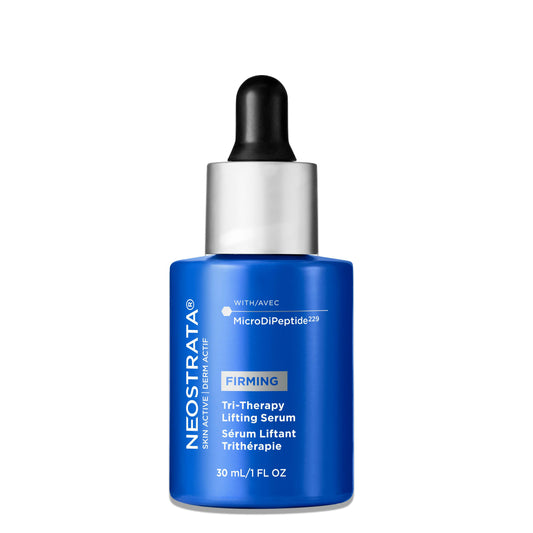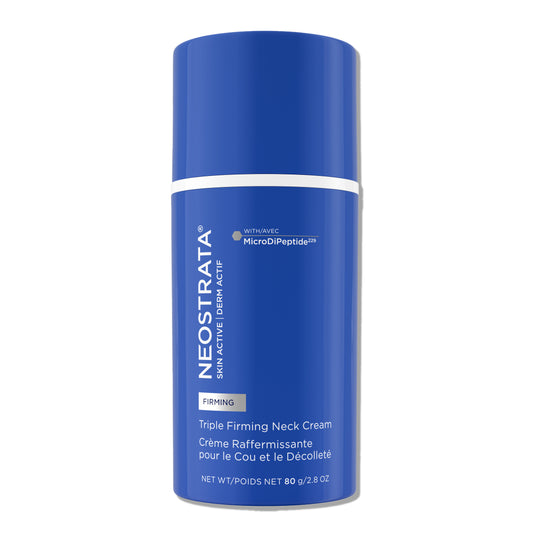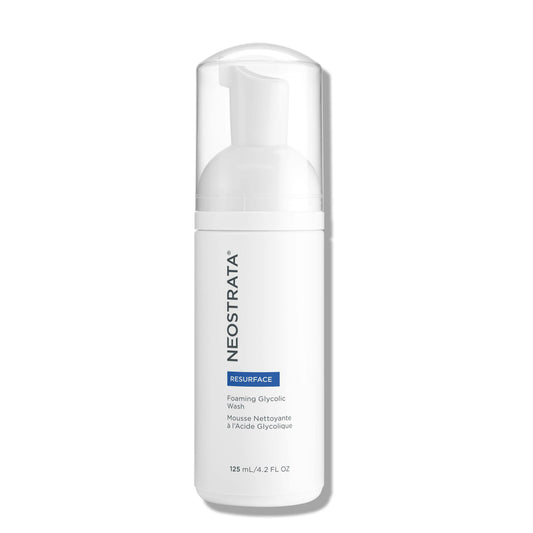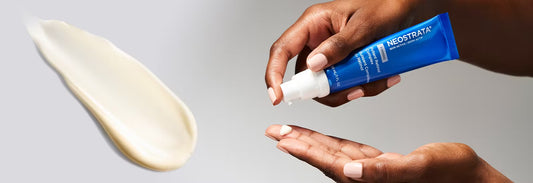Get Glowing: What Can Retinol Do For Your Skin?
The skin is a complex organ, and many of us are managing more than one concern when it comes to our skin. That’s why Retinol is such a superpower ingredient and a dermatologist go-to. This potent form of Vitamin A is used topically (applied to the skin’s surface) to visibly improve a multitude of skin conditions including fine lines and wrinkles, loss of firmness and skin discoloration.
Read on to learn more about what Retinol is and what it can do for your skin. We will also answer some of the most frequent questions we get about this potent ingredient.
What Is Retinol?
Retinol is a topical form of Vitamin A. These fat-soluble substances make up the family of ingredients called Retinoids. The fat solubility of this ingredient helps it absorb into the skin. Topical Vitamin A can be found in many forms, including Retinol, Retinal and Retinoic Acid.1
Retinol has many benefits for the skin. It works by speeding up skin cell turnover, having an exfoliation-like effect on skin. This mode of action makes Retinol an ideal ingredient to take on a multitude of skin concerns from signs of aging to discoloration and acne-prone skin.
What Does Retinol Do For Your Skin?
Retinol is a gold-standard, dermatologist recommended ingredient for good reason. It reduces the appearance of fine lines and wrinkles, uneven skin tone and dark spots. Retinol also has anti-comedogenic properties and helps clear pores to benefit acne-prone skin.
Did you know that Vitamin A was the first vitamin approved by the FDA for wrinkles?
Retinol is a potent form of Vitamin A that helps visibly improve skin texture. When Retinol is applied, it interacts with receptors in the skin to enhance skin turnover, speeding up the process of removing dead skin cells to reveal fresh new layers. The result is smoother, more supple looking skin and improvement in the appearance of fine lines and wrinkles.

Retinol Serum vs. Retinol Cream
Topical Retinol is available in many forms, but creams and serums are the most common.
Serums are lightweight and more absorbent than cream formulations, which are often thicker and slower to absorb than serums. Those with oily or combination skin may find the weight of a serum more aesthetically pleasing, whereas drier skin types may prefer the richer texture of a Retinol cream.
How to use Retinol
Retinol can be added to your daily regimen, giving you an effective boost to combat signs of skin aging, uneven skin tone and dark spots.
Most Retinol products should be applied in the evening due to their potential for sun sensitivity. There are some exceptions to this rule, including sunscreen products and those formulated with lower percentages of Retinol. When in doubt, refer to the application instructions on the product packaging.
Your skin may take some time to acclimate to Retinol, especially if this ingredient is new to you. Minimize the potential for drying or irritation by starting to use your Retinol products once every second or third day, and gradually building up to once daily as your skin’s tolerance increases.
Can Retinol help with acne and hyperpigmentation?
Clinical trials show the effectiveness of topical retinoids and recommend them as a first line of treatment for acne and hyperpigmentation.2 Retinol is a topical retinoid, available in non-prescription strength, that can play a role in improving the appearance of acne-prone skin and post-acne marks.
How does Retinol help acne-prone skin?
Retinol increases skin turnover, helping keep pores clear, reducing trapped oil and the problematic bacteria3 (p. acnes) that is known to contribute to acne breakouts.
Post-acne marks are another common concern for acne-prone skin sufferers. These reddish or darkened spots often remain long after a blemish has gone away, and particularly stubborn marks can remain on the skin up to 12 months after an acne lesion has healed. Retinol’s exfoliation action helps gradually fade the look of these spots, revealing more even-toned skin.
This same exfoliating action helps visibly improve hyperpigmentation at the skin’s surface including uneven skin tone, melasma and dark spots.
How does Retinol help skin turnover?
Retinol is known for its ability to enhance skin turnover, making it an effective antiaging ingredient. It’s also a fat-soluble ingredient, allowing it to penetrate skin’s surface layers.
Once applied to skin, topical Retinol penetrates the epidermis (outer layers of the skin) and binds to the appropriate receptor converting to Retinoic Acid in the skin’s surface layers. Once absorbed, it loosens connections between skin surface cells while speeding up keratinization (the creation of new skin cells).4
When Should I Use Retinol in My Skincare Regimen?
We’re often asked, “When should I use Retinol products?” Because there is a potential for sun sensitivity with many Retinol products, most are ideal for once daily use in the evening.
Retinol Serum/Treatment:
- Step 1: Cleanse with PHA Facial Cleanser, a gentle hydrating cleanser.
- Step 2: Apply Retinol treatment.
- Step 3: Follow with a moisturizer to help diminish Retinol’s potential drying effect.
Retinol Moisturizers:
- Step 1: Cleanse with a gentle hydrating cleanser, PHA Facial Cleanser
- Step 2: Apply Illuminating Serum for brightening
- Step 3: Finish with Pigment Controller, a cream featuring Retinol and NeoGlucosamine
Can I Use Vitamin C and Retinol Together?
Combining Retinol and Vitamin C in your skincare routine can be beneficial, especially when it comes to diminishing the appearance of uneven skin tone, dark spots and softening the look of post-acne marks.
The addition of Vitamin C adds a potent antioxidant to your routine that is known to defend against environmental aggressors such as air pollution, hot and cold temperatures, sunlight and cigarette smoke. Vitamin C, is not only a fighter against photodamage and discoloration, but it is also a powerful defender against fine lines and dull, rough skin texture.
Retinol and Vitamin C are a potent power couple when added to your daily skincare regimen. Vitamin C’s brightening and antiaging properties complement Retinol’s benefits. When these two ingredients team up, they help skin look brighter and more radiant, diminishing the look of fine lines and wrinkles while supporting a more lifted-looking complexion.
How to use Vitamin C and Retinol in a skincare regimen
The trick to using Vitamin C and Retinol together lies in applying these two ingredients properly. Vitamin C, especially in its pure form of L-Ascorbic Acid, is a potent ingredient. Layering Retinol and Vitamin C at the same time can lead to unwanted irritation without any potential benefit.
The best way to reap the benefits of this ingredient combination is to use your Vitamin C during the day (think of it as your antioxidant shield to defend against environmental aggressors) and follow with your Retinol products in the evening to replenish and rejuvenate your skin while you sleep.
Is Tretinoin the Same as Retinol?
Tretinoin5 or Retinoic Acid is the most bioactive form of topical retinoids. This powerful form of Vitamin A is up to 20 times more potent than Retinol and is a common prescription treatment for acne and wrinkles. Because of its bioactivity, Retinoic Acid carries higher potential for skin irritation and drying effects.
Retinol is one of the most frequently used ingredients when it comes to cosmeceutical skincare products and is a more tolerable option than Tretinoin or Retinoic Acid. This is because Retinol gradually converts to Retinoic Acid in the skin after application, giving time for the skin to acclimate.
Other commonly used forms of Vitamin A include Retinal, Retinyl Acetate and Retinol Palmitate. These Vitamin A derivatives tend to be gentler than Retinoic Acid and Retinol, but their benefits often take longer to appear and may not be as dramatic when compared to Retinol and Retinoic Acid.
What are the pros and cons of each form of Retinol?
Tretinoin/Retinoic Acid is the most bioactive form of Vitamin A and is often available in prescription strengths. Retinoic Acid is highly effective for minimizing the look of lines, wrinkles, uneven skin tone and dark spots. It also supports collagen for a firmer, more lifted look. This ingredient’s bioactivity carries with it a higher potential for signs of irritation like redness and itchiness, as well as drying, and flaking or peeling of the skin.
Retinol is the most common form of Vitamin A used in cosmeceutical skincare. It tends to be relatively stable in product formulations and is better tolerated than Retinoic Acid. Retinol is an effective ingredient for smoothing skin texture, diminishing the look of fine lines and wrinkles, uneven skin tone and dark spots. It has also been shown to visibly improve post-acne marks. This high strength ingredient has some potential for dryness and peeling or flaking skin. Look for Retinol formulations that include hydrating or soothing ingredients, like Potent Retinol Complex, to help balance the skin and minimize potential for irritation.
Retinal is a stable Vitamin A derivative often found in cosmetic formulations. This retinoid is well tolerated when compared to Retinoic Acid and is ideal for providing mild improvement in signs of photoaging, skin texture, fine lines and wrinkles.
Retinyl Acetate and Retinyl Palmitate are stable forms of Vitamin A that convert to Retinol in the skin. These retinoids are commonly found in skincare products. They offer benefits for improving the look of fine lines and wrinkles but have less dramatic effects than Retinol or Retinoic Acid.
Which Form of Retinol Should I Use in My Skincare Regimen?
Start your retinoid journey with Retinol because it offers multiple benefits with less irritation than Retinoic Acid – and it is suitable for all skin tones and skin types.
Those with normal, combination or oily skin can easily incorporate Retinol into their regimen. Dry skin types may want to add a humectant ingredient like Hyaluronic Acid to boost hydration and minimize any potential drying effect.
Those with sensitive skin can also use Retinol but should add this ingredient to their regimen slowly over time. If any redness or irritation develops, use every other day or every two days. If you still experience irritation, discontinue use. For an alternative ingredient, try Polyhydroxy Acids which are known for their gentle antiaging properties.
Retinol can be added to your regimen as early as your twenties or as late as your fifties or sixties. If you are experiencing particularly stubborn wrinkles or dark spots, consult your dermatologist. They may be able to provide more insight for in-office procedures such as peels and laser treatments or even recommending Retinoic Acid, a higher strength type retinoid.
Can You Use Hyaluronic Acid with Retinol?
Hyaluronic Acid is another ingredient that pairs well with Retinol.
This powerful humectant can bind many times its weight in water, bringing essential hydration to skin. Hyaluronic Acid balances the potential drying effect of Retinol to help minimize irritation.
How to use Retinol and Hyaluronic Acid together
Retinol and Hyaluronic Acid complement one another. Some Retinol products, for example, Potent Retinol Complex, are formulated with Hyaluronic Acid for added hydration.
To use Retinol and Hyaluronic Acid in your daily regimen, try layering these ingredients. Start by cleansing the skin and follow with your Retinol serum or treatment. Allow a few minutes for your serum to completely absorb before finishing with a Hyaluronic Acid moisturizer.
Which Retinol Product Should I Choose?
NEOSTRATA® Retinol treatments and moisturizers offer a variety of ways for you to reap the benefits of this workhorse skincare ingredient:
Retinol Serum/Treatments:
 |
Potent Retinol Complex : A nighttime treatment with 0.3% Pure Retinol, plus Niacinamide to tackle skin discoloration. Centella Asiatica (Tigergrass Extract) and Hyaluronic Acid are two additional nourishing ingredients to help balance skin and minimize potential for drying irritation.
|
 |
Comprehensive Retinol Eye Cream : This nighttime eye treatment provides the antiaging power of Retinol in a formulation gentle enough for the delicate eye area. Our eye cream has been shown to diminish the look of fine lines, crow’s feet and crepiness around the eye area, as well as improve dark circles.
|
Retinol Moisturizers/Creams:
 |
Matrix Support SPF 30 : This medium weight antiaging day cream combines broad spectrum SPF for sun protection with youth-building ingredients, NeoGlucosamine and Peptides for a results-focused daytime moisturizer. The 0.1% Retinol, combined with broad spectrum SPF in this formula, make it a perfect Retinol for daytime use.
|
 |
Pigment Controller : A potent brightening treatment, designed to take on uneven skin tone and dark spots. Pigment Controller is formulated with Retinol, NeoGlucosamine and Vitamin C for skin that looks noticeably brighter and more evenly toned.
|
What Should I Look For in a Retinol Skincare Product?
When choosing a cosmeceutical Retinol treatment, look for different forms of this ingredient found in skincare formulations:6
Retinol is one of the higher strength over-the-counter forms of Vitamin A found in skincare products. This pure stabilized form is highly effective for signs of skin aging, discoloration and acne-prone skin. Retinol is well tolerated by most, but there is some potential for drying or irritation for those with drier or more sensitive skin types. Minimize the downside of Retinol by working this ingredient into your regimen slowly over a period of one to two weeks.
Retinal is an aldehyde form of Vitamin A that is less irritating and better tolerated than Retinoic Acid. It provides mild improvement for fine lines, wrinkles, discoloration and uneven texture.
Retinyl Acetate and Retinyl Palmitate are Retinyl Esters. These ingredients are very stable in cosmetic formulations and offer anti-wrinkle benefits. These forms of topical Vitamin A provide antiaging benefits but with less dramatic effect than Retinol.
When seeking an effective Retinol product, we recommend looking for Retinol when possible, as this ingredient provides visible anti-wrinkle and skin smoothing benefits. Adding hydration can help minimize potential for any drying or irritation that may accompany use of this high strength ingredient.
Can You Use Retinol For Sensitive Skin?
Those with sensitive skin may think Retinol is not for them. Yet, sensitive skin types can benefit from this potent ingredient. Here are pros and cons of using Retinol on sensitive skin:
Pros of Retinol:
- Retinol is safe for sensitive skin.
- It provides the same benefits for wrinkles, uneven skin tone and acne-prone skin as other skin types receive.
- When sensitive skin is given time to acclimate to Retinol, tolerance can be built over time.
Cons of Retinol:
- Retinol use can have a drying effect and may contribute to redness, irritation, peeling or flaking.
The trick to using Retinol for sensitive skin is all about building tolerance over time and balancing Retinol with hydrating and soothing ingredients. Try these tips for Retinol use with sensitive skin:
- Start slow and low: Begin with lower concentrations of Retinol and use them once daily every third day. Gradually build tolerance by increasing frequency, working up to every other day and then to daily use over a one to three week period, depending on your sensitivity level. (Looking for a good starter Retinol? Try the 0.1% Retinol found in Pigment Controller.
-
Know when to step back: If you experience stinging, irritation or flaking and peeling of the skin, increase time between applications, allowing irritation to diminish before slowly increasing frequency of use.
Pro Tip: Skin cycling can be an effective way to incorporate Retinol into a sensitive skin regimen. Use Retinol for two days in a row and follow with two days of skin recovery using a soothing and hydrating treatment or serum, like Redness Neutralizing Serum with BioCalm Complex. - Hydrate, hydrate, hydrate: Minimize Retinol’s potential drying effect by adding hydrating ingredients such as Hyaluronic Acid, Polyhydroxy Acids (PHAs) and NeoGlucosamine to your daily regimen. A gentle, non-drying cleanser is a good foundation for any sensitive skin regimen. Add a soothing moisturizer with emollient properties to help support the skin barrier and prevent trans-epidermal water loss.
What to Look For When Choosing Retinol to Use with Sensitive Skin
Look for Retinol formulations that include balancing and hydrating ingredients such as botanicals, Hyaluronic Acid or NeoGlucosamine. Our Potent Retinol Complex is a high strength Retinol serum with nourishing Centella Asiatica, Hyaluronic Acid and NeoGlucosamine to provide the benefits of Retinol while minimizing the potential for irritation.
In Conclusion
Retinol is a proven ingredient when it comes to addressing multiple skin concerns, including lines and wrinkles. It’s also a versatile ingredient that helps diminish the appearance of uneven skin tone and dark spots and is beneficial for acne-prone skin and post-acne marks.
If you’re looking for a potent workhorse ingredient to tackle your skin concerns, add Retinol to your regimen and say hello to radiant, glowing skin.











